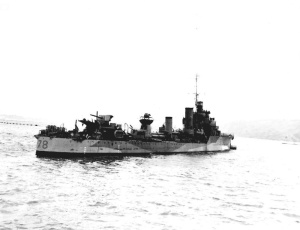
HMS Wolverine was an Admiralty modified W-class destroyer built for the Royal Navy. She was one of four destroyers ordered in April 1918 from James Samuel White & Co Ltd under the 14th Order for Destroyers of the Emergency War Programme of 1917–18. She was the seventh Royal Navy Ship to carry the name. It had been introduced in 1798 for a gun brig and last borne by a destroyer sunk after a collision in 1917.
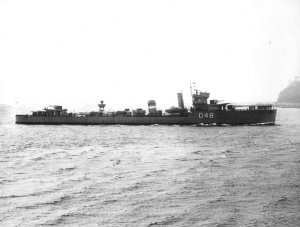
HMS Vidette (D48) was an Admiralty V-class destroyer of the Royal Navy. Built at the end of the First World War, she served in the final months of that conflict, and saw extensive service in the inter war years and in World War II. She was an effective convoy escort and U-boat killer, being credited with the destruction of five U-boats during the Battle of the Atlantic. HMS Vidette transported Spike Island Republican Prisoners to Bere Island Internment Camp in 1921. *Refer Spike Island’s Republican Prisoners, 1921 by Tom O’Neill MA.
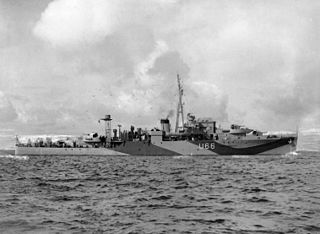
HMS Starling, pennant number U66, was a Modified Black Swan-class sloop of the Royal Navy. She was active in the Battle of the Atlantic during the Second World War and was the most successful anti-submarine warfare vessel of the Royal Navy, being credited with the destruction of fourteen U-boats.

HMS Woodpecker, pennant number U08, was a Black Swan-class sloop of the Royal Navy. She was active during the Second World War and was a successful anti-submarine warfare vessel, being credited with the destruction of six U-boats.

HMS Arbutus was a Flower-class corvette of the Royal Navy, which was active during the Second World War. She was a successful escort vessel, and took part in the destruction of two U-boats during the Battle of the Atlantic. Arbutus was sunk in the North Atlantic in February 1942.
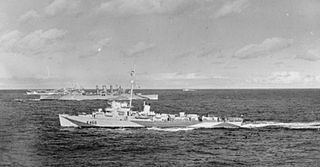
HMS Bickerton was a Captain-class frigate of the Royal Navy. She served during the World War II as a convoy escort and anti-submarine warfare vessel in the Battle of the Atlantic and was an effective U-boat killer, being credited with the destruction of two U-boats during a service career of just 10 months. Bickerton was lost in action on 22 August 1944.

HMS Magpie, pennant number U82, was a Royal Navy Modified Black Swan-class sloop launched in 1943 and broken up in 1959. She was the seventh Royal Navy ship to bear the name. She was reclassified as a frigate in 1947, receiving a new pennant number F82. The ship was the only vessel commanded by Prince Philip, Duke of Edinburgh, who took command on 2 September 1950, when he was 29.

HMS Conn was a TE ("Buckley") Type Captain class frigate of the Royal Navy. She served during World War II as a convoy escort and anti-submarine warfare vessel in the Battle of the Atlantic and was credited with the destruction of two U-boats during the conflict.

HMS Duckworth (K351) was a Captain-class frigate of the Royal Navy. She served during the Second World War as a convoy escort and anti-submarine warfare vessel in the Battle of the Atlantic and was an effective U-boat killer, being credited with the destruction of five U-boats during the conflict.

HMS Fame was an F-class destroyer built for the Royal Navy during the 1930s. Although assigned to the Home Fleet upon completion, the ship was attached to the Mediterranean Fleet in 1935–36 during the Abyssinia Crisis. During the Spanish Civil War of 1936–1939, she spent time in Spanish waters, enforcing the arms blockade imposed by Britain and France on both sides of the conflict. Fame served in the Norwegian Campaign in 1940 before she was severely damaged when she ran aground in October. The ship was refloated several months later and spent a year and a half under repair. Fame was converted into an escort destroyer while under repair and was assigned to escort duties in the North Atlantic when the repairs were completed in mid-1942.
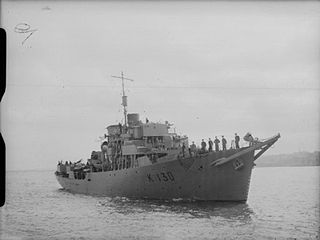
HMS Lotus was a Flower-class corvette that served in the Royal Navy.
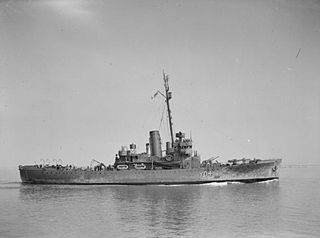
The Banff-class sloop was a group of ten warships of the Royal Navy. Built as United States Coast Guard Lake-class cutters, in 1941 these ships were loaned to the Royal Navy as antisubmarine warfare escort ships. The transfers took place at the Brooklyn Navy Yard; the sloops were manned for transport to Britain by personnel from the damaged battleship Malaya which was under repair there.

HMS Keppel was a Thornycroft type flotilla leader built for the Royal Navy at the end of the First World War. She was completed too late to serve in that conflict, but saw extensive service in the inter war years and in World War II. She was an effective convoy escort and U-boat killer, being credited with the destruction of five U-boats during the Battle of the Atlantic. She was the second of three ships named for 18th century Admiral Augustus Keppel.

Convoy JW 58 was an Arctic convoy sent from Great Britain by the Western Allies to aid the Soviet Union during World War II. It sailed in March 1944, reaching the Soviet northern ports in early April. All ships arrived safely. JW 58 was attacked by German U-boat and aircraft but suffered no losses. Three U-boats were destroyed and six aircraft were shot down during these operations.

HMS Stork (L81) was a Bittern-class sloop of the Royal Navy. She was active during the Second World War, serving in convoy escort groups, and was a successful anti-submarine warfare vessel, being credited with the destruction of four U-boats.

HMS Wanderer (D74/I74) was an Admiralty modified W class destroyer built for the Royal Navy. She was the seventh RN ship to carry the name Wanderer. She was ordered in January 1918 to be built at the Fairfield Shipbuilding and Engineering Company, Govan in Glasgow, being launched in May 1919. She served through World War II where she was jointly credited with five kills on German U-boats, more than any other ship of her class. In December 1941 the community of Sutton Coldfield in Warwickshire officially adopted her. In 1943 she was one of twenty one V&W class destroyers to be converted as Long Range Escorts. She was decommissioned after the war and sold for scrap in 1946.

HMS Blankney was a Hunt-class destroyer of the Royal Navy and was the first and so far only warship to bear the name. She was laid down on 17 May 1940 at John Brown & Company, Clydebank, Scotland, launched on 19 December 1940 and commissioned on 11 April 1941.

HMS Wren (U28) was a Black Swan-class sloop of the Royal Navy. She was active during the Second World War and was a successful anti-submarine warfare vessel, being credited with the destruction of five U-boats.

HMS Rochester (L50) was a Shoreham-class sloop of the Royal Navy. She served during the Second World War and was a successful anti-submarine warfare vessel, being credited with the destruction of five U-boats.

Clive Gwinner (1908–1998) was a Royal Navy officer who served during the Second World War. He was a successful Anti-Submarine Warfare commander, being credited with the destruction of seven U-boats during the Battle of the Atlantic.




















